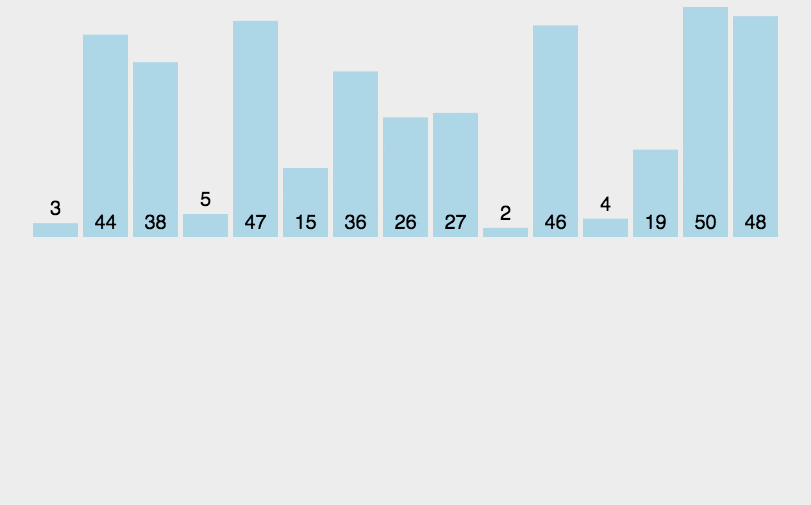外部排序(归并排序)
定义
基本思想及步骤
步骤
1.思想 一

2.思想 二




实现操作
1.二路归并
1.1.c
递归
1 //二路一次归并过程的算法 2 //low为本次二路归并排序的第1有序区的第1个元素,i指向第1个元素, mid为第1有序区的最后1个元素 3 void merge(int List[], int low, int mid, int high) 4 { 5 //mid+1为第2有序区第1个元素,mid为第1有序区的最后1个元素 6 //i 指向第 1 有序区的第 1 个元素 7 int i = low; 8 //j 指向第 2 有序区的第 1 个元素,high 为第 2 有序区的最后一个元素 9 int j = mid + 1; 10 //temp数组暂存合并的有序序列 11 int *temp = new int[high - low + 1]; 12 //设置临时数组的指示标志 k 13 int k = 0; 14 //内存分配失败 15 if(!temp){ 16 cout<<"数组分配失败!"; 17 exit(0); 18 } 19 //顺序选取两个有序区的较小元素,存储到t数组中,因为是递增排序 20 while(i <= mid && j <= high){ 21 //较小的元素,存入temp临时数组中 22 if(List[i] <= List[j]){ 23 temp[k++] = List[i++]; 24 }else{ 25 temp[k++] = List[j++]; 26 } 27 }// end of while 28 //比完之后,假如第1个有序区仍有剩余,则直接全部复制到 temp 数组 29 while(i <= mid){ 30 temp[k++] = List[i++]; 31 } 32 //比完之后,假如第2个有序区还有剩余,则直接全部复制到 temp 数组 33 while(j <= high){ 34 temp[k++] = List[j++]; 35 } 36 //将排好序的序列,重存回到 list 中 low 到 high 区间 37 for(i = low, k = 0; i <= high; i++, k++){ 38 List[i] = temp[k]; 39 } 40 //delete [] 删除动态数组的内存 41 delete []temp; 42 } 43 44 //递归实现二路归并排序(也就是分治法的思想) 45 void mergeSort(int List[], int low, int high) 46 { 47 //二路归并排序,分为二路 48 int mid = (low + high) / 2; 49 //终止条件,low >= high, 不是while,且不含等号,否则死循环 50 if(low < high) 51 { 52 //递归过程,二路归并排序递归过程 53 mergeSort(List, low, mid); 54 mergeSort(List, mid + 1, high); 55 //归并 56 merge(List, low, mid, high); 57 } 58 } 59 60 int main(void) 61 { 62 int source[7] = {49, 38, 65, 97, 76, 13, 27}; 63 64 mergeSort(source, 0, 6); 65 66 for (int i = 0; i < 7; i++) { 67 printf(" %d ", source[i]); 68 } 69 70 return 0; 71 }
非递归
1 //非递归算法实现二路归并排序,length代表数组长度,即数组最大下标是 legth - 1 2 void mergeSort(int List[],int length) 3 { 4 //回忆图解的过程,二路归并算法的流程,不同于递归,递归是先递归语句,然后归并函数,这样归并函数是倒序执行(和递归函数执行顺序相反) 5 int size = 1; 6 int low; 7 int mid; 8 int high; 9 //size 是标记当前各个归并序列的high-low,从1,2,4,8,……,2*size 10 while(size <= length - 1) 11 { 12 //从第一个元素开始扫描,low代表第一个分割的序列的第一个元素 13 low = 0; 14 //当前的归并算法结束的条件 15 while(low + size <= length - 1) 16 { 17 //mid代表第一个分割的序列的最后一个元素 18 mid = low + size - 1; 19 //high 代表第二个分割的序列的最后一个元素 20 high = mid + size; 21 //判断一下:如果第二个序列个数不足size个 22 if(high > length - 1){ 23 //调整 high 为最后一个元素的下标即可 24 high = length - 1; 25 } 26 //调用归并函数,进行分割的序列的分段排序 27 merge(List, low, mid, high); 28 //打印出每次归并的区间 29 cout << "low:" << low << " mid:" << mid << " high:" << high << endl; 30 //下一次归并时第一序列的第一个元素位置 31 low = high + 1; 32 }// end of while 33 //范围扩大一倍,二路归并的过程 34 size *= 2; 35 }// end of while 36 }
1.2.c++
递归
非递归
1.3.python
递归
非递归
1 def mergeSort(arr): 2 import math 3 if(len(arr)<2): 4 return arr 5 middle = math.floor(len(arr)/2) 6 left, right = arr[0:middle], arr[middle:] 7 return merge(mergeSort(left), mergeSort(right)) 8 9 def merge(left,right): 10 result = [] 11 while left and right: 12 if left[0] <= right[0]: 13 result.append(left.pop(0)); 14 else: 15 result.append(right.pop(0)); 16 while left: 17 result.append(left.pop(0)); 18 while right: 19 result.append(right.pop(0)); 20 return result





















 1904
1904

 被折叠的 条评论
为什么被折叠?
被折叠的 条评论
为什么被折叠?








